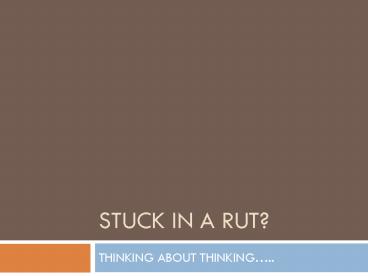STUCK IN A RUT - PowerPoint PPT Presentation
1 / 15
Title:
STUCK IN A RUT
Description:
Of these, diagnosis is by far the most important for upon it the success of the ... to consider this as a differential in that facial palsy that's actually Bell's ... – PowerPoint PPT presentation
Number of Views:51
Avg rating:3.0/5.0
Title: STUCK IN A RUT
1
STUCK IN A RUT?
- THINKING ABOUT THINKING..
2
- The three main tasks of the clinician are
diagnosis, prognosis and treatment. Of these,
diagnosis is by far the most important for upon
it the success of the other two depend -
J A Ryle
3
SESSION PLAN and AIMS
- Explore, briefly, the diagnostic process
- Small group problem solving session
- Solutions to problems
- Introduction to heuristic learning theory
- At the end of the session you should have an
understanding of how heuristic learning theory
may inform/influence your clinical practice
4
HOW DO WE DIAGNOSE DISEASE?
5
DIAGNOSTIC PROCESSES
- Pattern recognition
- Hypothetico-deductive reasoning
- Information gathering
6
WHAT SKILLS DO WE NEED?
7
SKILLS NEEDED FOR CORRECT DIAGNOSIS
- Disease knowledge base
- Communication skills
- Examination skills
- Diagnostic reasoning skills
- Organisational skills
8
DIAGNOSTIC REASONING SKILLS
- Ability to assess baseline probability of disease
- Understanding of diagnosticity of symptoms,signs
and tests - Ability to recognise new symptoms and signs and
revise diagnosis - Ability to use diagnostic heuristics
9
Heuristics are short-cuts or rules of thumb that
we use in problem solving
- We all use them, all the time but probably arent
aware we are doing it - Heuristics are often the difference between
experienced doctors and those that are more
junior - Heuristics may aid rapid, accurate diagnosis but
they can also be the source of error - More of this later..
10
MEANS-END ANALYSIS
- The ability to look ahead to a possible diagnosis
and structure history, examination and
investigation accordingly.
11
ANTI-LOOPING HEURISTIC
- This represents our reluctance to re-analyse
data, re-order tests, reconsider previously
discarded diagnoses as we dont like to feel we
are taking backward steps instead of advancing - Recognising this reluctance in ourselves enables
us to be aware when it occurs and take steps to
counteract it
12
ANCHORING
- This has good and bad points
- On the bad sideif we dont think outside the
box sometimes we might miss those more obscure
diagnoses - We may rely too heavily on one piece of info
- On the good sidecommon things ARE common
13
AVAILABILITY
- We probably use this a lot without realising
- If youve just seen a case of Lyme Disease youre
more likely to consider this as a differential in
that facial palsy thats actually Bells - That patient with a fever must have Swine Flu
because the newspapers say it is rife - A patient might argue that smoking isnt bad for
you because his Gran smokes and shes 100 today
14
SOME SIMPLE HEURISTICS WE USE
- Red flags
- Time
- Any more..?
15
(No Transcript)































